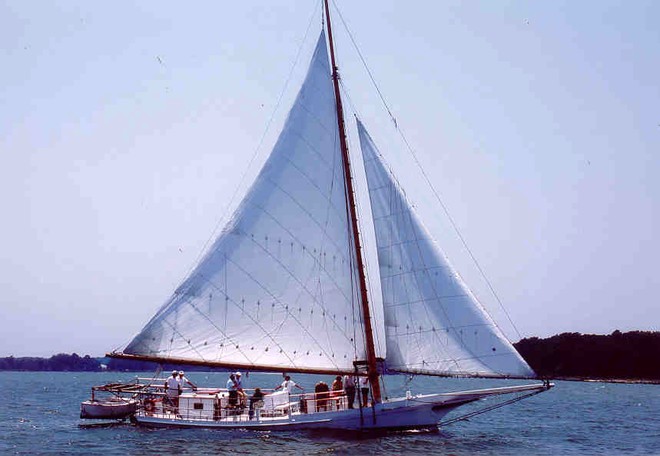The graceful Skipjack - sailing into history
by Lee Mylchreest on 14 Mar 2011

Skipjack on a leisure cruise SW


In the Third World sailing boats are still a familiar sight, used for transport and fishing.
Their delicate sails enliven the horizons of many a coastal waterway.
In the Western World they have long been relegated to the field of pleasure and sport - except for a few hardy survivors, and the whimsically named Skipjack is one of them.
A century ago, hundreds of skipjacks plied the Chesapeake Bay in Maryland on the eastern shores of the USA, sailing her waters and dragging dredges in search of oysters so lucrative they were called Chesapeake Gold.
With their distinctive shallow draft and two-sail rig, skipjacks were a unique - and iconic - workboat of the Chesapeake Bay.
Now there are believed to be only six working skipjacks left in Maryland. And just four have reported catching oysters so far this season: Hilda M. Willing, Thomas Clyde, Fannie L. Daugherty and Somerset.
The skipjacks are victims as much of the changing times as the dwindling oyster populations. It just doesn't make much sense these days to sail big, wooden sailboats to catch fewer and fewer oysters.
There are perhaps a couple dozen skipjacks on the bay, but most are owned by nonprofit ventures and museums or used as pleasure boats or for charter cruising trips.
'It's been slipping every year for the last hundred at least,' said Christopher White, author of 'Skipjack: The Story of America's Last Sailing Oystermen.' 'I'm actually surprised these six men working today are still out there dredging. I would have predicted they would have not made it as long as this. It just goes to show you how much grit and tenacity they have to keep working.'
White spent time with skipjack captains in the 1990s, working on the boats and chronicling the dying way of life for his book, which was published in 2009.
The gaff rigged Skipjack was specifically developed to dredge for oysters in Chesapeake Bay. In the late 1800s, more than a thousand reportedly plied the bay. They were relatively inexpensive to build, and their shallow draft enabled them to dredge oysters closer in to shore. Watermen often built the craft themselves in their backyards.
Deal Island is one of the last bastions of oyster dredging, and still holds a skipjack race every Labor Day. In the old days in boom times they could catch 400 or 500 bushels a day. It was grueling work, though, sailing through all kinds of weather in fall and winter.
But oyster harvests plummeted in the late 1980s, as diseases devastated the bay's once-abundant shellfish. The statewide catch is a fraction of what it was before.
About the Skipjack:
The skipjack is sloop-rigged, with a sharply raked mast and extremely long boom (typically the same length as the deck of the boat). The mainsail is ordinarily triangular, though gaff rigged examples were built. The jib is self-tending and mounted on a bowsprit. This sail plan affords the power needed to pull the dredge, particularly in light winds, while at the same time minimizing the crew required to handle the boat.
The hull is wooden and V-shaped, with a hard chine and a square stern. In order to provide a stable platform when dredging, skipjacks have very low freeboard and a wide beam (averaging one third the length on deck). A centerboard is mounted in lieu of a keel. The mast is hewn from a single log, with two stays on either side, without spreaders; it is stepped towards the bow of the boat, with a small cabin. As typical in regional practice the bow features a curving longhead under the bowsprit, with carved and painted trailboards. A small figurehead is common. A typical skipjack is 40 to 50 feet in length. The boats use direct link Edson worm steering gear mounted immediately forward of the transom.
The dredge windlass and its motor are mounted amidships, between the mast and deckhouse. Rollers and bumpers are mounted on either side of the boat to guide the dredge line and protect the hull.
If you want to link to this article then please use this URL: www.sail-world.com/81343